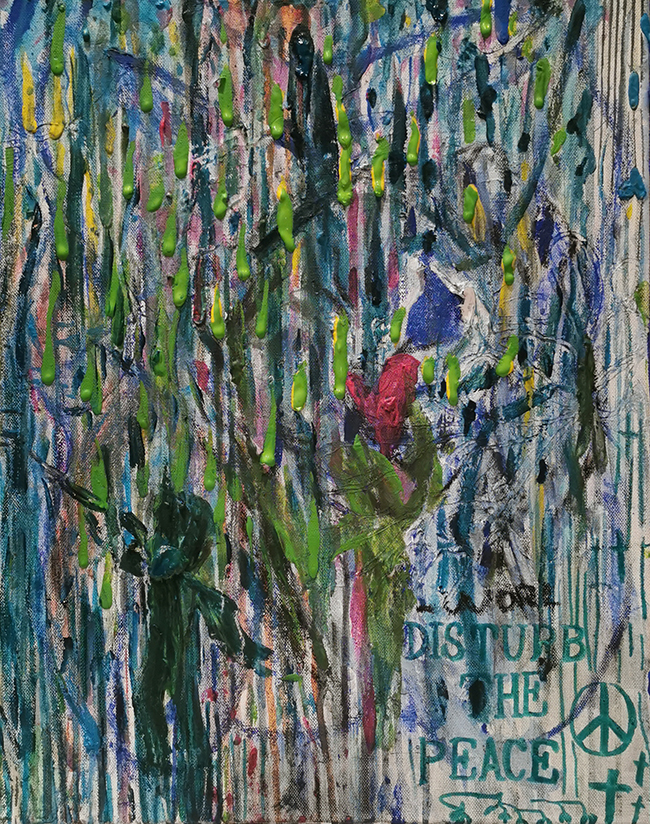Kun Fang is a versatile artist based in Antwerp, Belgium, whose work encompasses painting, illustration, video, and design. With her diverse skill set, she brings a fresh perspective to each medium. Throughout her career, Kun has participated in over 30 exhibitions in cities such as London, Berlin, Moscow, Athens, Shanghai, Tokyo, Chengdu, and Seoul. Her creativity showcases her ability to connect with viewers through both emotional depth and technical skill.
Kun’s art explores themes of identity, culture, and connection. This pursuit often brings her to the intersection of the personal and universal, where emotions are vivid and stories transcend borders. One of her recent works, 安易 (Peace/Vrede/Paix/Barış), exemplifies her ability to create a visual language that speaks across divides.

Kun Fang’s 安易 (Peace) is a mixed-media painting on canvas, sized 40 x 50 cm. It captures the complexity of peace, not as a static state but as a layered and evolving idea. The piece features an abstract backdrop of dripping colors—green, blue, and yellow—each hue contributing to the atmosphere of the work. While these colors convey a sense of calm and natural balance, the fluidity of the drips suggests motion and impermanence, hinting that peace requires effort to sustain.
The painting features a bold red heart, drawing the viewer’s eye and serving as the focal point. The heart feels like both a literal and symbolic representation, potentially symbolizing love, empathy, or human connection—elements essential for peace to exist. The red contrasts sharply with the muted tones of the background, giving it prominence without overwhelming the composition.
Another intriguing element of the work is the presence of a faint, hidden human figure. Embedded within the dripped background, the figure appears almost ghostly, blending into the flow of colors. This subtle detail invites reflection on humanity’s role in peace. The figure is neither dominant nor entirely clear, suggesting that peace is a collective, shared responsibility rather than the work of one person. This visual choice also mirrors how people can sometimes feel invisible or overlooked in broader conversations about global or interpersonal harmony.
Adding another layer to the painting is a peace sign, quietly situated within the composition. Unlike the heart, which commands attention, the peace sign feels understated, almost secondary. This placement feels deliberate, as if to say that symbols of peace, while recognizable and important, are not enough on their own. They must coexist with deeper values and actions, represented by the heart and the hidden figure.
The title of the piece, 安易 (Peace/Vrede/Paix/Barış), reflects Kun’s interest in breaking language barriers. By including translations of “peace” in multiple languages, the title reminds viewers of the universality of its message. While the languages come from different corners of the world, the meaning remains the same, underscoring our shared human desires.
Kun’s decision to layer these translations into the title rather than the visual space keeps the painting’s message both specific and open-ended. The title anchors the work, while the imagery allows for individual interpretation. It’s a thoughtful balance that gives the piece its quiet power.
Kun’s use of mixed media is central to the piece’s impact. The dripping technique introduces an organic unpredictability, with the colors blending and overlapping in ways that feel spontaneous yet deliberate. This interplay between control and chaos mirrors the reality of peace itself—it’s rarely perfect, often messy, and always in flux.
The red heart is painted vividly, standing out against the free-flowing background. The hidden figure and peace sign are more subtle, almost encouraging the viewer to lean in and search for meaning. This interplay between bold and subtle elements invites both an immediate emotional connection and deeper contemplation.
Kun Fang’s 安易 (Peace) is a reflective and layered work. It doesn’t demand attention through loud declarations but instead invites viewers into a quiet, contemplative space. The dripping background reminds us of peace’s fragility, the red heart calls for love, the hidden figure asks us to see ourselves in the effort, and the peace sign ties it all together with a universal symbol.
In a time when division often feels easier than understanding, Kun’s work feels like a gentle reminder of what unites us. Through her artistry, she creates a space for thought, emotion, and, perhaps, a little more empathy. This is art that speaks softly but resonates deeply, much like the idea of peace itself.

